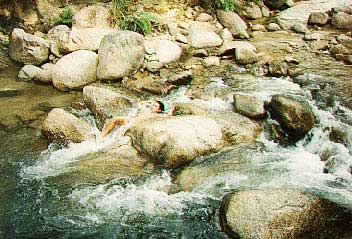How old is a river?
 Rather:
How does one measure the age of a river? Where is it young; where old?
Rather:
How does one measure the age of a river? Where is it young; where old?
A river is so convenient an allegory of the human condition. We speak of its “youth” in its tumbling headwaters, tossing and foam-flecked, pristine and clear but for the turbulence of its passage down through the mountain passes of its “birth.” Then comes its “maturity”, as it flows in wide meanders through the lowlands, broad and deep and full, joined and fed by tributaries as a man in his maturity is fed by friendship and love. Then its “old age” -- perhaps even, these days, its “senescence” -- as poisoned by the effluent and debris of life it creeps enfeebled and noisome to the coast, there to open at last into the limitless sea, to shed its burden of gathered sediment and surrender its molecules to their vast oceanic repository; the river goes, indeed, to Meet its Maker.
The allegory works. So well, indeed, as to seem too obvious. A river flows, is linear, moves from Here to There, like Time. A river changes its landscape, slicing through stone and flensing away the Earth, performing enormous feats of work while seeking only the Path of Least Resistance, like Humanity. And thus the River is a motif common to all mythologies; a theme central to the oldest stories.
And yet, the allegory seems to turn upon itself: the Snake swallows its own tail. The oldest part of the river is not where it opens to the sea, but where it bubbles forth from a cleft in montane rocks. For there, at its spring, is where the river began. If there is a Beginning and an End, how can the End be older than the Beginning? The Beginning was here first. When first the rains fell upon the mountain and trickled into the runnels that gathered into the streams that spawned the river: this was a time ancient indeed. The pure cold waters that now spurt and tumble through those primordial stone channels: how can we see them as “young”? Perhaps, only in the sense of being “new-born”, which is to say, newly opened to our senses. We call something “new-born”, when in truth it is we who are new to it. We see it for the first time, and we regard it as having had no existence before our witness. So we enshroud a thing on illusion at the very moment of its appearance before us.
So the River is oldest at its “birth”place, as a cradle is the oldest home of all things. The apparent linearity of its subsequent progression -- to the lowlands, meandering, opening to the sea -- is no more than a function of the way we observe it. The River is at no point “older” or “younger” than at any other point; it is at every point as old as the hills. The River merely alters its form to suit the demands imposed upon it by the environment, the changing terrain. When it “dies” in the ocean, it dies not at all, but returns to its true “youth”: a purity greater even than at its source, that bubbling spring in the mountains. It becomes ethereal, lighter than air, floating up as a vapour to fall as rain upon the hills... it is tempting to say here, “to begin the cycle anew”, but the cycle has neither Beginning nor End; it merely Is.
So when we contemplate
a River, and find ourselves tempted to impart to it the stages of our own
mortality, perhaps we should turn the allegory around, and allow the River
to impart to us its own and true immortality.